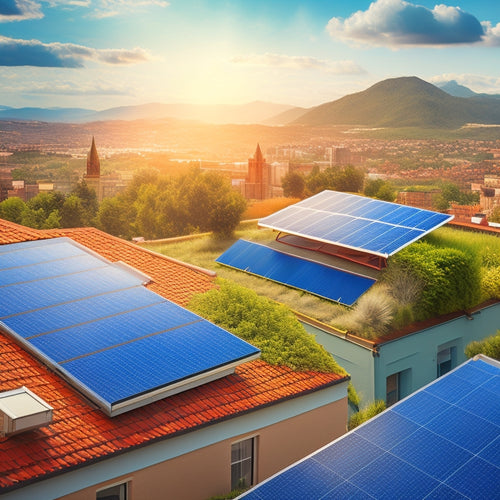
DIY Guide: Natural Insulation for Energy-Efficient Walls
Share
You're looking to ditch traditional insulation materials for a more eco-friendly approach. Natural insulation options like hemp, cellulose, and wool can provide similar R-values while reducing your carbon footprint. Before you start, it's crucial to prepare your walls by evaluating damage, identifying gaps, and analyzing moisture control. Then, choose a sustainable insulation method that suits your climate and budget. By following a thorough installation plan, you can guarantee a snug fit and maximize energy efficiency. As you investigate natural insulation, you'll uncover the benefits of improved indoor air quality, cost savings, and a reduced risk of moisture damage - and that's just the beginning.
Key Takeaways
- Choose sustainable natural insulation materials like hemp, cellulose, or wool batts that suit your climate and budget for optimal energy efficiency.
- Prepare walls for insulation by inspecting for cracks, gaps, and water damage, and addressing these issues to ensure successful installation.
- Install natural insulation materials accurately and snugly, following manufacturer instructions and expert advice, to maximize performance.
- Measure and evaluate insulation effectiveness using R-value, thermal resistance testing, and hot box tests to ensure energy efficiency and compliance with building codes.
- Avoid common mistakes like overlooking essential details, neglecting installation errors, and allowing moisture accumulation to ensure the longevity and safety of your natural insulation.
Natural Insulation Materials Overview
Your quest for eco-friendly home insulation begins with understanding the various natural insulation materials available.
You'll be surprised by the range of options that not only reduce your carbon footprint but also provide excellent thermal performance. Hemp insulation, with its high R-value and moisture-wicking properties, is a top contender.
Cellulose fiber, made from recycled paper products, is another popular choice. Additionally, incorporating renewable energy solutions into your home's infrastructure can further enhance its energy efficiency.
Wool batts offer a sustainable alternative to traditional fiberglass, while cork panels provide a natural, non-toxic option. Straw bales, recycled denim, and cotton insulation are also viable alternatives.
If you're looking for something more unconventional, earth bags made from soil and sand can be used as a natural insulation material.
Preparing Walls for Insulation
You'll need to inspect your walls thoroughly before installing natural insulation, so create a wall inspection checklist to identify potential issues.
Evaluating wall damage, such as cracks, gaps, and water damage, is essential to guarantee the insulation performs at its best and doesn't exacerbate existing problems.
Additionally, enhancing route planning and logistics streamlined logistics can also contribute to a more energy-efficient process.
Wall Inspection Checklist
Before adding natural insulation, inspecting your walls is essential to confirm a successful and efficient process.
You'll want to identify the type of wall materials you're working with, such as wood, brick, or drywall, as this will impact the insulation types you can use.
Check for any gaps, cracks, or openings in the walls, including electrical outlets, windows, and doors.
Verify that the walls are level, plumb, and securely fastened.
Regular maintenance and inspections, similar to those used in fleet maintenance, can help identify potential issues early on.
Look for signs of water damage, rot, or pest infestation, and verify that the walls are clear of debris and obstructions.
Assessing Wall Damage
Three key areas of wall damage to evaluate are cracks, water damage, and pest infestation.
You'll want to inspect walls for any cracks, no matter how small, as they can compromise wall integrity and allow air leaks. Shifting to renewable energy sources, such as solar and wind power, can also enhance energy security and resilience in your home renewable energy sources.
Water damage can lead to structural issues and create an ideal environment for pests. Check for signs of water damage, such as discoloration, warping, or musty odors.
Pest infestation can also weaken walls, so look for signs of termite activity, carpenter ant damage, or rodent nests.
Evaluating wall damage is essential for effective moisture control and guaranteeing your insulation installation is successful.
Installing Natural Insulation Methods
This stage of the process involves preparing your home for the natural insulation installation, which requires careful planning and execution to guarantee maximum energy efficiency and effectiveness.
You'll need to choose sustainable options that fit your climate, budget, and personal preferences. Consider factors like R-value, moisture resistance, and fire safety when selecting materials.
Next, develop a thorough installation plan, including installation techniques and sequencing. Confirm you have the necessary tools and materials before starting the job. Measure and mark the wall cavities accurately to confirm a snug fit.
Begin installation from the bottom up, working in small sections to maintain quality control. To maximize energy production, it's crucial to optimize solar panel array design, considering factors such as tilt, sizing, and orientation.
Follow manufacturer instructions for specific installation techniques, and don't hesitate to consult experts if you're unsure.
Benefits of Natural Insulation
By opting for natural insulation methods, you're not only reducing your carbon footprint but also reaping a multitude of benefits that directly impact your living space and the environment.
Natural insulation provides sustainability benefits by minimizing the use of synthetic materials, reducing waste, and promoting eco-friendly practices.
Additionally, you'll enjoy cost savings through reduced energy consumption, as natural insulation helps regulate your home's temperature more efficiently. This, in turn, leads to lower energy bills and a more comfortable living space.
With natural insulation, you'll experience improved indoor air quality, reduced noise pollution, and a decreased risk of moisture damage.
Measuring Insulation Effectiveness
You'll need to measure the effectiveness of your natural insulation to verify it's performing as expected.
To do this, you'll use metrics like R-Value measurement, which indicates an insulation material's ability to resist heat flow.
R-Value Measurement
How effectively does your insulation really work? Measuring its effectiveness is vital to guarantee your walls are energy-efficient. That's where R-value measurement comes in.
R-value is a measure of an insulation material's ability to resist heat flow. It's important to understand the R-value factors that affect your insulation's performance, such as material type, density, and thickness.
To put your insulation to the test, consider the following:
-
R-value comparison: Compare the R-value of your insulation material to others to verify you're getting the best performance.
-
Climate zone: Your location's climate zone affects the recommended R-value for your insulation.
-
Wall assembly: The R-value of your entire wall assembly, including framing and finishes, matters.
-
Age and condition: Insulation performance degrades over time, so consider the age and condition of your insulation.
-
Installation quality: Proper installation appreciably impacts your insulation's R-value.
Heat Flow Analysis
Measuring insulation effectiveness involves analyzing heat flow through your walls, which is critical to understanding how well your insulation is performing.
By understanding heat flow, you'll identify areas where heat transfer occurs, including thermal bridges that can compromise your insulation. Thermal bridges are sections of your wall where the insulation is disrupted, allowing heat to escape.
To analyze heat flow, you'll need to evaluate factors like wall orientation, window placement, and exterior finishes. You'll also need to account for air leakage, as it can greatly impact heat transfer.
Thermal Resistance Testing
Most building codes require a minimum thermal resistance of R-13 to R-19 for exterior walls, depending on the climate zone.
Now that you've selected your natural insulation material, it's time to measure its effectiveness. Thermal resistance testing determines how well your insulation performs in reducing heat flow. You'll want to assess the thermal conductivity of your chosen material to confirm it meets the required standards.
To evaluate insulation performance, you'll need to:
- Conduct a hot box test to measure the material's thermal conductivity
- Perform a guarded hot plate test to assess its thermal resistance
- Calculate the material's R-value based on its thermal conductivity
- Compare your results to the required R-value for your climate zone
- Consider factors like moisture absorption and aging effects on insulation performance
Common Mistakes to Avoid
When it comes to natural insulation, overlooking essential details can lead to poor performance, moisture damage, or even safety hazards.
You'll want to avoid common mistakes that can compromise your insulation's effectiveness. Don't fall prey to insulation myths, such as assuming that natural insulation is always better than synthetic materials.
In reality, the right choice depends on your climate, budget, and personal preferences. Installation errors, like inadequate compression or incorrect moisture protection, can also undermine your insulation's performance.
Verify you follow the manufacturer's instructions and take necessary precautions to avoid moisture accumulation.
Frequently Asked Questions
Can I Mix Natural Insulation Materials for Better Performance?
As you commence on a quest for eco-friendly innovation, like a medieval alchemist seeking the philosopher's stone, you'll find mixing natural insulation materials enhances sustainability benefits, but weigh the cost comparison carefully to guarantee your energy-efficient kingdom stays within budget.
How Do I Handle Moisture Issues in Existing Walls?
When tackling moisture issues in existing walls, you'll need to identify sources of moisture and apply effective wall treatments, such as vapor-permeable coatings or membranes, to prevent damage and guarantee a healthy indoor environment.
Are Natural Insulation Materials Fire-Resistant?
When choosing natural insulation, you'll want to prioritize fire resistance properties that meet insulation safety standards. Look for materials with proven track records, like wool or recycled denim, which have been tested and certified to guarantee your safety and peace of mind.
Can I Use Natural Insulation in Load-Bearing Walls?
You'll need to confirm the natural insulation material you choose is compatible with your load-bearing walls' structural demands, as it must maintain the load-bearing capacity while providing thermal insulation, so research and testing are essential to secure a safe and efficient solution.
Do Natural Insulation Materials Attract Pests or Rodents?
While cozying up with natural insulation, you're probably wondering: do these earthy materials invite unwanted guests? Fortunately, you can outsmart pests with pest prevention strategies and rodent deterrent options, ensuring your eco-friendly abode remains critter-free and energy-efficient.
Related Posts
-

5 Efficient Air Circulation Methods for Green Homes
You can utilize the power of natural ventilation techniques, whole house fans, and solar-powered ventilation systems ...
-

What Roofing Materials Best Protect Our Planet?
As you consider the environmental impact of your building, you're likely to find that the roofing material you choose...
-

7 Smart Air Purification Hacks for Energy-Savvy Homes
You can notably improve your indoor air quality while minimizing energy consumption by implementing strategic air pur...


